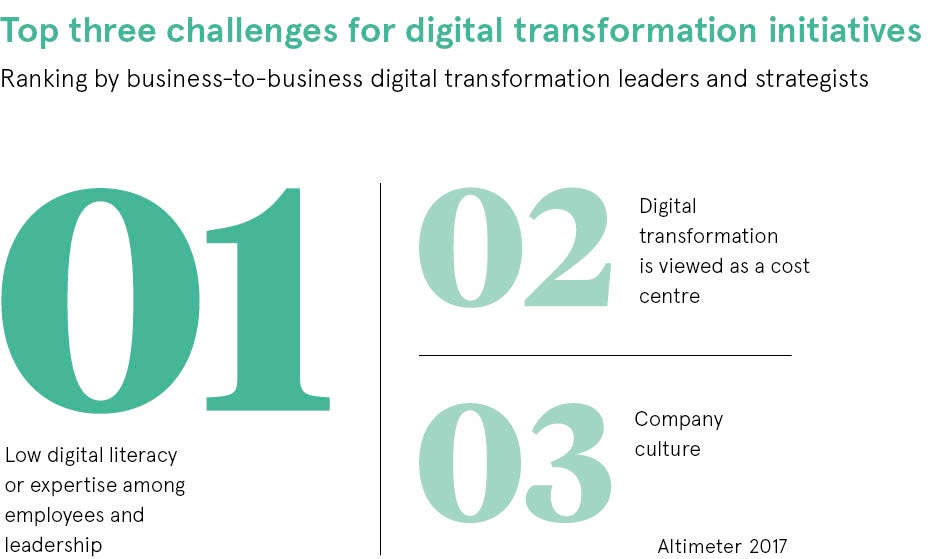The very public troubles of some of the UK’s most-famous high street retailers should leave business leaders in little doubt about the pressing need for digital transformation. If House of Fraser can wobble, how can you survive without questioning your entire digital strategy?
Yet, you see, that is almost exactly the problem. Having a digital strategy is not what digital transformation is about.
“Companies often equate digital transformation with IT transformation – that is a recipe for disaster,” says Dr Gianvito Lanzolla, professor of strategic leadership at Cass Business School.
Cranfield Business School’s professor of business strategy Mark Jenkins adds: “The idea you can park digital transformation off in some department, or with a chief digital or innovation officer, is wrong. Unless organisations think about how these disruptions can affect their model, they are going to die.”
Digital transformation is not so much about digital strategy, but more about business strategy
Has the term “digital transformation” lost meaning?
Euan Semple, author of Organizations Don’t Tweet People Do, agrees. “Digital transformation straddles existing silos – human resources, communications, marketing and, yes, technology – but they all need to be part of the solution,” he says.
As well as lacking Ronseal’s premise of “doing what it says on the tin”, the phrase “digital transformation” has become overused. “Like so much, it has been turned into a thing, oversold and it has ended up as a damp squib,” says Mr Semple.
David Woodhead, an award-winning consulting director in digital strategy with Sopra Steria, who works with clients in central government, says: “Digital transformation is increasingly meaningless, since it’s used indiscriminately. For any enterprise to be viable and sustainable it has to deliver increasing levels of operating efficiency and enhance its customer experience.”
Digital transformation, then, is not so much about digital strategy, but more about business strategy.
“Almost without exception, the best customer or citizen experience is also the most operationally efficient for the enterprise, so all interests are aligned and there is an overwhelming imperative for fresh thinking,” says Mr Woodhead.
CEOs must relinquish some control and embrace failure in digital strategy
The problem, says Renee Tsielepi of agile consultancy Transcendence, is that many business leaders have no idea what they need to do.
“It can be a huge shift of mindset and not one they can do instantly,” she says. “As an example, a C-level might have trouble letting go of control, to which I would recommend small steps like letting your partner drive the car instead of you, or someone else choosing your clothes one day. Once you start reprogramming your brain that you don’t always have to be in control and nothing bad happens, you can start bringing this into the workplace.”
Once chief executives have challenged themselves, they can then ask others to do the same, effectively inviting them up the leadership ladder.
Ms Tsielepi says retraining business leaders to allow employees to fail is also vital. “If you don’t allow employees to fail, they won’t experiment or innovate, which would be crippling,” she says.
While chief executives understand only too well the threats of nimble disruptors, they are paralysed because they are creative and can see the possibilities, but will not destroy an existing business model that still makes money.
Three digital strategy options for business transformation
Professor Lanzolla says paralysed business leaders needing to embrace digital transformation can do it in one of three ways.
The first is the digital garage approach, setting up an innovation lab, for example. Yet how do you integrate these ideas?
The second is the agile approach in which agile teams, leadership or whole organisations experiment from within. The challenge here is that experimentation with a framework becomes a mess.
The third is the top-down approach, where a leader takes a business decision to transform which permeates throughout the organisation. “This is a massive undertaking because you cannot envisage all the implications of digital technologies,” says Professor Lanzolla.
GE has tried to do it and many have accused the company of not moving quickly enough; the jury is out on whether it will succeed. Carmakers, used to producing metal vehicles rather than being a showcase for connected car technology, face similar problems.
Microsoft, which arguably was not born a digital company in the modern sense, is succeeding. “It has a very clear plan of how it wants to transform,” says Professor Lanzolla.
Successful digital strategy: build less, experiment more
Underpinning transformation is a digital strategy that can be summed up as “building less”; experiment rapidly and continuously, but in the digital environment.
Professor Jenkins says this is evident in his specialist field of motorsports, where he is known as the F1 Professor. He says: “Simulation technology is transforming the speed at which organisations can develop new products because you will no longer need to develop the physical prototypes. We are going to see a compression of timescales and cost base.”
In practice, coming up with your own strategy might work better than hiring expensive consultants, says Professor Jenkins.
“Stay close to your customers and find ways to become more agile; find ways to speed up the cycle of testing concepts and bringing them to market,” he says.
Professor Lanzolla adds: “The bottom line is that digital transformation is very painful. Digital technologies are so pervasive that it is no longer a question of whether companies should use them. Companies must have a digital strategy for everything they do because it transforms customer engagement, employee engagement and optimisation of operations. If you don’t do it, you are not in the game.”
Ms Tsielepi notes: “The same will happen as in the Industrial Revolution. Those not adapting and embracing the changes will be displaced by some level of automation.”
But will business leaders embrace new business strategies? “People talk transformation, but they only want tinkering,” says Mr Semple, arguing that most chief executives are not standing on the burning platforms that would make them jump.

